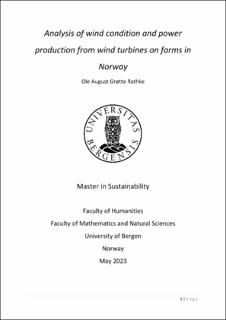| dc.description.abstract | Our world is heating up; we have reached a global temperature of 1.1 °C and will surpass the 1.5-degree target, and as the world increases its electrification, more power is needed. The current global electricity mix comprises 63.3 % of fossil fuel and 36.7 % of renewables. In Norway, our primary electricity source is from hydroelectric dams; however, as more energy is needed and to meet the 2030 GHG emission target, more renewable energy source has to be built. Is it possible to have wind turbines on farms to meet this future demand and help with the energy transition? - What is the wind and power generation potential on Norwegian farms? With data taken from the NORA3 wind data set and map data on agricultural areas in Norway from Statistics Norway (SSB), I found the wind speed, at a height of 40 meters, for the major Norwegian agricultural areas between 2010 and 2018. In my study I found that the best wind conditions are in Rogaland, with Nordland, Møre og Romsdal, Troms og Finnmark, and Agder having good wind conditions, especially near the coast . Vestland has medium good wind conditions while Trøndelag, Vestfold og Telemark, Viken, and Innlandet have the lowest wind speeds out of the 10 counties. -What is the typical power production potential for each county? Hourly wind data from 2010 to 2018 was used to calculate the power generated by the turbine. The data presented on the map are in kWh, meaning that this is the energy each turbine generates during one hour on average. Three turbines were selected; however, the Vestas V39 turbine has the potential to extract the most out of the wind available. Though the T100 turbine has the lowest power coefficiency, we can still expect it to perform better in lower wind situations due to its lower cut-in wind speed. -How does it compare to the power demand for a typical milk barn and household? The V39 turbine can generate enough energy for the farm in most of the counties. We can see that Vestfold og Telemark can generate enough electricity except from April to September. Innlandet and Viken can generate enough power in February, March, and December. Trøndelag also does not have enough wind for the V39 to meet demand in July and August. Rogaland, Nordland, Troms og Finnmark, Møre og Romsdal, Agder, and Vestland can meet the power demand of the farm during all months. -What sustainability issues can turbines cause? Wind turbines are a renewable energy source with no emissions during operation. Large-scale wind turbines emit 11 grams of CO2/kWh and coal 980 grams of CO2/kWh. A medium-scale turbine (500 kW) emits approximately 30 grams of CO2-eq/kWh, and a 100 kW turbine releases approximately 55 grams of CO2-eq/kWh. So, the smaller the turbine, the more CO2 it will release during its lifetime. The fact that wind turbines can contribute to cleaner and more affordable energy does not mean that they are not harmful. Some of the SGDs can conflict with the gathering of material for the construction, operation, and the end of life for wind turbines. Wind turbine uses various metals for its construction. These metals are a finite resource and will run out eventually. Many renewable technologies rely on these metals, including wind turbines. To meet demand future demand for metals, companies are exploring the potential of seafloor mining as the demand for these rare metal increase with the demand for more renewable energy sources. However, though sea floor mining might sound like a good idea to meet future demand, it is unknown territory, and we do not know the consequence the mining activities will have on fish and plants and the ecosystem. Sediments can be kicked up during mining activity which then gently drop to the ocean floor again; however, due to ocean currents, these sediments can travel long distances past the mining area. This might cover plants and ocean-dwelling creatures with the sediments, limiting their feeding ability. It is undoubtedly that wind turbines cause deaths among local fauna, and the placement of these turbines is related to this. Wind turbines on farms will likely have less impact on local fauna due to the turbine's smaller size and location. Current wind farms are placed primarily in areas untouched by humans; farms are in areas with human activities, and there is less likelihood that this will disturb feeding grounds for reindeer and flying predators. | |
